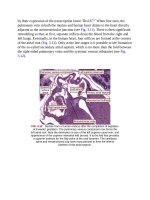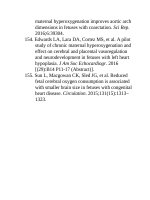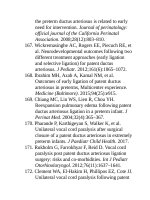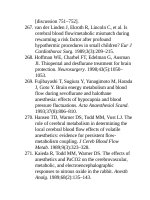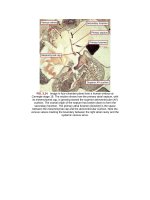Andersons pediatric cardiology 1068
Bạn đang xem bản rút gọn của tài liệu. Xem và tải ngay bản đầy đủ của tài liệu tại đây (95.55 KB, 3 trang )
operation,originallydescribedbyReidandcolleagues37andpopularizedby
Barbero-Marcialandcolleagues,38involvedadirectanastomosisbetweenthe
pulmonaryarteriesandtherightventricle,withtheanterioraspectofthe
anastomosisbeingaugmentedwithamonocusporpericardialpatch(Fig.40.20).
TheBrazilianseriesasinitiallyreportedinvolvedseveninfantsagedfrom2to9
months.38Ofthese,onediedearly,butnolatedeathswerereported.Duringa
shortperiodoffollow-up,patientswerefunctionallywell,althoughthe
monocuspvalvefrequentlybecameregurgitant.Inaseriesreportedfrom
Birmingham,intheUnitedKingdom,itwasobservedthatmortalitywassimilar
inpatientswhounderwentrepairusingadirectanastomosis,comparedwith
thoseinwhomavalvedconduithadbeenused.39However,thefreedomfrom
reinterventiontotherightventricularoutflowtractwasgreaterinthosehaving
directanastomosis.Similarly,inasmallseriesofpatientsfromParis,thosewho
underwentsurgerywithoutaconduithadlowerratesofreinterventionandbetter
growthofthecentralpulmonaryarteries.40Thusthisapproachmayhavesome
benefits,althoughfurtherstudieswillberequired,particularlytoexaminethe
impactofthepulmonaryregurgitation,whichisuniversalafterthistypeof
modification.
FIG.40.20 Repairofcommonarterialtrunk,withoutaconduit.(A)The
pulmonarytrunkisanastomosedtotherightventricle.(B)Theanterior
aspectoftheanastomosisandpulmonarytrunkisaugmentedwitha
monocusp.
Analternativesolutiontoovercomethelimitedsupplyofhomograftshasbeen
tousealternativetypesofconduit.Althoughanumberofdifferenttypeshave
beenused,41,42therehasbeenmuchinterestintheContegraconduit
(Medtronic).Thisisaheterologousbovinejugularvenousgraftcontaininga
trileafletvenousvalve.Itisavailableinsizesassmallas12mm,makingit
potentiallyidealforreconstructingtherightventricularoutflowtractinneonates
andinfants.However,therehavebeenrecentconcernswithrespecttothe
developmentofacceleratedstenosisintheconduit,particularlywhensmallsizes
areused.Itappearsthatconduitsoflessthan16mmareathigherriskof
obstruction.43,44InpatientswhoreceivedeitheraContegraconduitora
homograftforarangeofsurgicalprocedures,multivariate,propensity-scored
matchingsuggestedthattheuseoftheContegraconduitindependentlypredicted
thenecessityforreplacement(hazardratioof3.7).45
Truncalregurgitationremainsasignificantchallenge.Ingeneral,regurgitation
ofevenmoderateseverityshouldbedealtwithconservatively.Wheresevere
regurgitationexists,oftenresultingfromprolapseofarudimentaryleafletofthe
truncalvalve,thevalveneedstoberepaired,orrarelyreplaced.Inoneseriesof
72patients,preoperativeechocardiographicassessmentdemonstratednoor
minorregurgitationin30,regurgitationthatwasmildin25,moderatein10,and
severein7.Adecisiontoperformsurgerytothetruncalvalveatthetimeof
truncalrepairwasmadein16patients.Theanatomicfactorsassociatedwiththe
needforsurgerytothetruncalvalveincludedanabnormalnumberofvalvar
leaflets,whichmaybedysplastic,andanabnormaloriginofthecoronary
arteries.46Repairofthetruncalvalvemaybeperformedatthetimeofthe
neonatalrepairorlater,oftenatthetimeofrevisionoftherightventricle-topulmonaryconduit.47Forpatientsundergoingrepairofthetruncalvalveatthe
timeoftheircompleterepair,datafromtheSocietyofThoracicSurgeons
indicatethatearlymortalityishighat30%,beingparticularlyhighinthosealso
requiringconcomitantrepairoftheaorticarch,whenitreached60%.48Shorttermhemodynamicimprovementisfeasible,althoughby10yearsaftersurgery,
thefreedomfromreoperationwasonly23%inthelargestseriespublishedto
date.49Surgicalcreationofatricuspidtruncalvalveappearedtoprovidethebest
outcomesforthesepatients.
Successfulsurgicalcorrectioncanalsobeachievedwhentheaorticarchis
interrupted.Theoriginalsuccessfulrepair,describedbyGomesandMcGoon,50
inwhichtheductwasleftinplacetosupplybloodtothedescendingaorta,isnot
nowused.Atthetimeofcompleterepair,theductandallductaltissuemustbe
excised.Theentirethoracicaorta,thepulmonaryarteries,theheadandneck
vessels,andtheductmustbethoroughlymobilized,sothattheascendingand
descendingpartsoftheaortacanbejoined.Surgeryisperformedusingprofound
hypothermiaandcirculatoryarrestoralternativelybyusingthetechniqueof
continuouscerebralperfusion.Ithasbeensuggestedthat,ifthearchcanbe
advancedandtheanastomosisperformedwithoutusingapatchtoaugmentit,
therequirementforreinterventionmaybereduced.51Somepatientsmaypresent
beyondtheneonatalperiod.Surgicalrepairinsuchpatientsmaystillbepossible,
althoughpreoperativecardiaccatheterizationtoassessthereactivityofthe
pulmonaryvascularbedisimportant,andcarefulmanagementofthepulmonary
vascularbedisessentialinthepostoperativeperiod.52,53Preoperativeuseof
pulmonaryvasodilatorsmayallowforsomeremodelingofthepulmonary
vascularbedinpreparationforsurgery.
